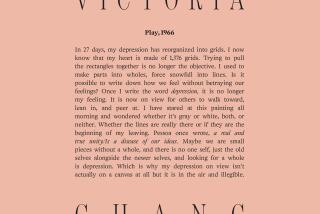Review: A movable feast of words in Ray Johnson books
Although artist Ray Johnson created plenty of conventional art objects — mostly quixotic, irreverent collages — his most sustained efforts took the form of letters, sent to hundreds of recipients, including such art stars as Andy Warhol, Yoko Ono and John Cage. Throughout his 40-year career, he zealously monitored the membership of his own artistic movement, the New York Correspondance School (misspelling and double or triple innuendoes intentional). And although he detested the term — or any label, for that matter — he was a leading practitioner of mail art, in which language and the letter opened onto endless chains of meaning.
Selections from this prodigious output are lovingly documented in two new titles from Siglio Press. “The Paper Snake” is a reprint of a 1965 artist’s book first published by Johnson’s friend Dick Higgins for his Something Else Press. “Not Nothing: Selected Writings by Ray Johnson, 1954-1994” is a more comprehensive collection edited and capably introduced by writer and translator Elizabeth Zuba. They are both remarkable for their fidelity to Johnson’s eclectic, off-the-cuff aesthetic.
“The Paper Snake” is the more arty and cohesive of the two — although “cohesive” hardly applies to anything Johnson did. Limited in time frame and scope — the work is based on mailings the artist sent to Higgins in the early ‘60s — it is a slim, decorous volume, printed in muted shades of blue and brown. The text is reproduced as Johnson typed or hand-wrote it, studded with small illustrations and collages. Artful combinations of lists, stream-of-consciousness observations, poems and aphorisms, the pages reveal an artist playing with the ambiguities and limits of language, in particular the conventions of letter writing. One missive begins, “Dear Dick,” immediately followed by, “P.S. I enclose four booms. Boom, boom, boom, boom.”
Gertrude Stein was clearly a touchstone for Johnson, and “Not Nothing” delves even further into his fascination with word play and the meanings pregnant in any combination of symbols. Johnson’s original layouts are often instrumental to these meanings, and the 380-page volume reproduces each selection as an image, preserving the typography, illustrations and even the wrinkles in the paper. Items are presented chronologically, and the effect is a bit like paging through a personal archive.
What emerges is not a portrait but a rather hazy silhouette of a man in thrall to the generative possibilities of words as hubs around which meaning swirls. Johnson reveled in the misapprehensions occasioned by typos, homophones and non sequiturs. Had he lived into the digital age, I’m sure he would have enjoyed the many mishaps wrought by auto-correct. (He committed suicide in 1995 by backstroking into the ocean — a final vector to explore.)
Whereas most of us try to cultivate focus, Johnson seems to have focused on cultivating distraction. His writings circle back on themselves, devolve into nonsense or trail off in mid-sentence, recording moments or thoughts so fleeting they are usually beneath notice. He dubbed these experiences “moticos,” likening them to images flying by on the side of a train. His dogged adherence to living in the moment was either an extreme openness — being tuned into all channels at once — or extreme self-indulgence — believing that anyone was interested in the minute-by-minute wanderings of his thoughts.
Like real life, “The Paper Snake” and “Not Nothing” are by turns intriguing and boring, revealing “Ray Johnson” to be a thoroughly slippery artistic construction. They are fitting tributes to an artist whose greatest work was perhaps himself.
Mizota is a writer and librarian in Los Angeles.
The Paper Snake
Ray Johnson
Siglio: 48 pp., $34.70
Not Nothing
Selected Writings by Ray Johnson, 1954-1994
Ray Johnson, edited by Elizabeth Zuba
Siglio: 380 pp., $45 paper
More to Read
Sign up for our Book Club newsletter
Get the latest news, events and more from the Los Angeles Times Book Club, and help us get L.A. reading and talking.
You may occasionally receive promotional content from the Los Angeles Times.






